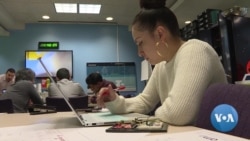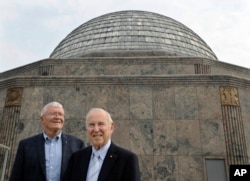College student Fatima Guerra, 19, will be the first to admit, she’s into some really nerdy stuff.
“Like, up there nerdy.”
"Way up there nerdy," she says. "All the way up into space."
Guerra is an astronomer in training, involved since a high school internship with a small project at the Adler Planetarium, with big goals.
“Our main goal was to see if the ozone layer is getting thinner and by how much, and if there is different parts of the Earth’s atmosphere getting thinner because of the pollution and greenhouse gases,” she told VOA from the laboratory at the Adler where she often works.
Coding ThinSat
Data that sheds light on those circumstances is gathered by a small electronic device called “ThinSat” designed to orbit the Earth. It is developed not by high-paid engineers and software programmers, but by Chicago-area students like Guerra.
“We focused on coding the different parts of the sensors that the ThinSat is composed of. So, we coded so that it can measure light intensity, pressure.”
“This stuff is very nerdy,” Jesus Garcia admits with a chuckle.
“What we hope to accomplish is look at Earth from space as if it was the very first exoplanet that we have. So, imagine that we are looking at the very first images from a very distant planet.”
As a systems engineer, Garcia oversees the work of the students developing ThinSat for the Adler’s Far Horizon’s Project, which he outlines “bring all types of students, volunteers and our staff to develop projects, engineering projects, that allow us to answer scientific questions.”
Garcia says the students he works with on the project cross national, racial and cultural divides to work toward a common goal.
“Here at the Adler, we have students who are minorities who have been faced with challenges of not having opportunities presented to them,” he said. “And here we are presenting a mission where they are collaborating with us scientists and engineers on our first mission that is going into space.”
Rocket carries project into space
As the NASA-owned, Northrop Grumann-developed Antares rocket successfully blasted off from the coast of Virginia on April 17, it wasn’t just making a resupply mission to the International Space Station.
On board was ThinSat, the culmination of work by many at the Adler, including Guerra, who joined the Far Horizons team as a high school requirement that ended up becoming much more.
“A requirement can become a life-changing opportunity, and you don’t even know it,” she told VOA. “It’s really exciting to see, or to know, especially, that my work is going to go up into space and help in the scientific world.”
Daughter of immigrants
It is also exciting for her parents, immigrants from Guatemala, who can boast that their daughter is one of the few who can claim to have built a satellite orbiting the Earth.
“I told them it might become a worldwide type of news, and I’m going to be a part of it. And they were really proud. And they were calling my family over there and saying, ‘She might be on TV.’ And it’s something they really feel a part of me about,” Guerra said.
Long after the data compiled by ThinSat is complete, Guerro will still have a place in history as a member of a team that put the first satellite developed by a private planetarium into space.
She says her friends don’t think that’s nerdy at all.
“It’s cool, because it’s interesting to see that something so nerdy is actually going to work, and is going to go up into something so important,” she said.











